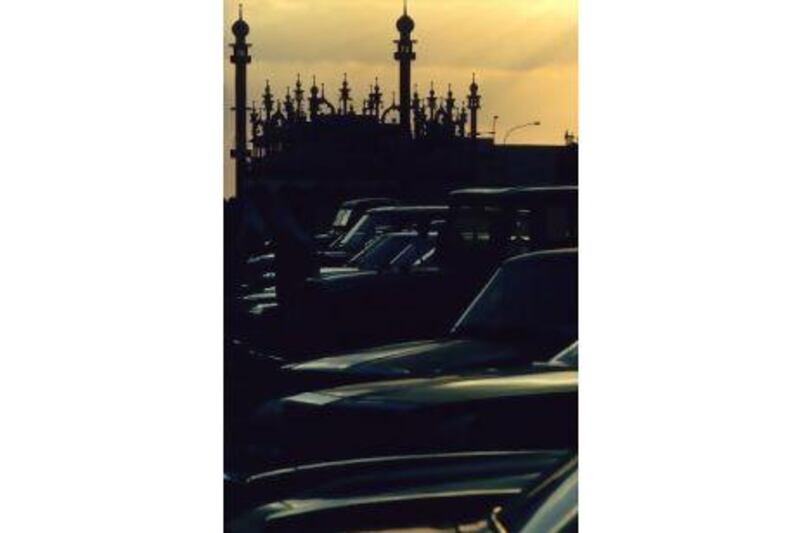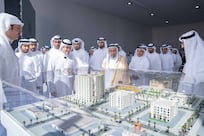Landmarks have stood near the top of Abu Dhabi's Airport Road for many years, a new one - it would seem - for each stage of the capital's development.
The oversized cannon, coffee pot, makabbah and mabaakhur of Al Ittihad Square, each a traditional symbol of Emirati identity, are only the latest monuments to stand on the site.
Some still remember the ornate clock tower, replete with falcons and fountains, that once stood in the middle of the Corniche, but very few residents can recall the ornate and brightly coloured mosque, covered in fine inscriptions and whimsical minarets that once sat at the junction of Airport Road and Al Istiqlal and Khalifa streets.
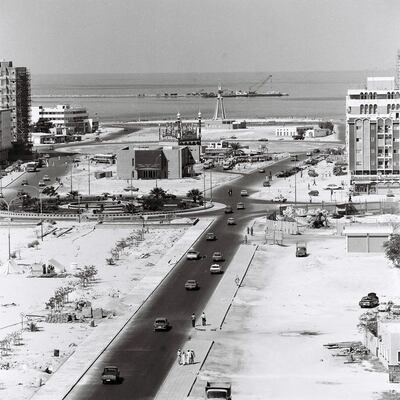
The mosque's roundabout remains - the last of nine that once punctuated Airport Road between the Corniche and the Maqta - but was cropped during a subsequent phase of road improvements and is now a fraction of its former size.
Nothing remains of the mosque now except crumbling foundations, faded photographs, and the distant memories of people who once came here to pray.
Abubakir Mattar, a local barber from Kerala, has lived in the local neighbourhood for more than 30 years and when he sees Jack Burlot's photographs, he beams.
"Do you know I had forgotten about this place, but now I remember praying here many years ago. It was very beautiful."
Saif Anwar, another former congregant, still prays nearby but can only wag his long white beard when asked about the mosque's disappearance.
"I do not know, but it was very old, maybe more than 30 years. It was called the Al Fahimi mosque."
Conversations with the Al Fahim family reveal that Anwar is correct on both counts. A mosque was originally built on the site in the 1940s by Mohammed Al Sayyri, but Abduljalil Mohammed Al Fahim, the founder of the current Al Fahim dynasty and a man who was to become one of Sheikh Zayed's close advisers, renovated the earlier structure in the late 1960s.
His brother, Ahmed Mohammed Al Fahim, became the mosque's imam and the building's rich, Mughal-influenced decoration is said to have resulted from the background of the construction team, who were originally from Pakistan.
This pattern of construction, renovation and disappearance marks the Al Fahim mosque as an important historical example, not only of mosque-building in Abu Dhabi, but also of the underlying pattern of post-oil urban development in the UAE.
Ronald Hawker, an art historian and author of Building on Desert Tides: Traditional Architecture of the Arabian Gulf, explains.
"When oil concessions were first negotiated and money began to flow into Emirati communities, the first thing people did was rebuild the mosques. Sometimes the mosques were reconstructed on the same footprint as the original building, but with new electrical and plumbing fixtures."
Issues of piety, cleanliness and modernisation became key factors not just in the construction of new mosques, but also in the disappearance of old ones.
The Al Fahim mosque was also an interesting example of patronage, a practice that remains an important avenue of identity in the UAE through contemporary sponsorship of charitable organisations, cultural and sporting events.
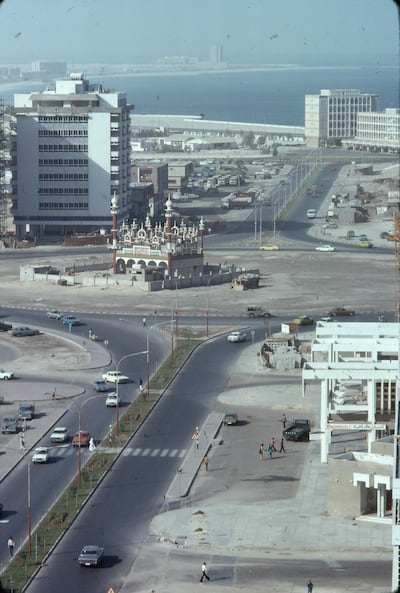
While it was highly unusual for an entire mosque to be the product of a single patron, congregants would often group together to make donations of everything from land and cash to labour and support for the imam.
Another of Abu Dhabi's notable vanished mosques was also associated with an important local family, the Al Otaiba. As the Jami, or Friday mosque, the Al Otaiba was Abu Dhabi's principal place of worship, the direct predecessor not only of its immediate replacement, the Sheikh Khalifa bin Zayed I Mosque, but also of the Sheikh Zayed Grand Mosque of today. After Qasr Al Hosn, it was one of the largest and most important buildings in old Abu Dhabi.
Though it had stood for almost 70 years near the present site of the British Embassy, the decision to demolish the Al Otaiba mosque in 1977 was made on the basis that renovation would be prohibitive. It was also decided, quite reasonably, that a larger mosque was needed - there was only room for 70 worshippers inside the Al Otaiba - and that the congregation deserved up-to-date facilities that included modern air-conditioning; however, the congregation's gain was vernacular architecture's loss.
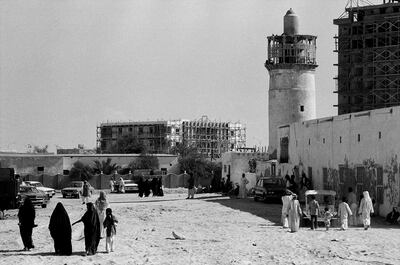
As can be seen from the photo above, the Al Otaiba mosque had a striking minaret decorated with fine wood carving and screens.
According to Anthony Harris, the British ambassador to the UAE at the time of its demolition, the Al Otaiba also included a prayer hall with 72 columns, each of which were more than four metres tall.
More than mere objects of nostalgia, the Al Fahim and Al Otaiba mosques bear testimony to local heritage and traditions, but they also highlight the importance of conserving Abu Dhabi's more recent architectural heritage.
In the case of the Al Otaiba mosque - made from local materials that proved ideally adapted to Abu Dhabi's harsh climate - they are also a source of inspiration to contemporary architects interested in creating a more sustainable city that works in harmony with nature.
